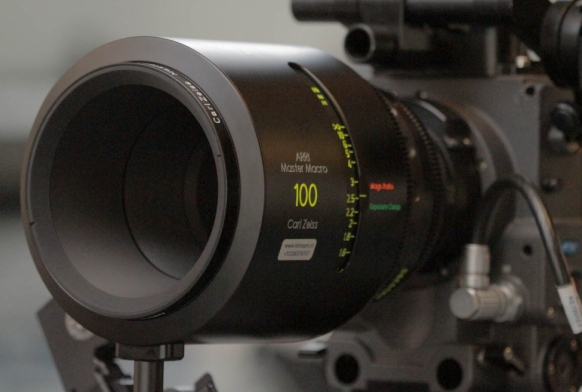
Zeiss Master Macro 100mm
- 100 mm macro lens with 1:1 magnification ratio
- novel optical design optimized for close-up work
- long focal length allows greater distance to subject
- expanded focus scale (1.4x revolutions) for greater accuracy
- can be used with lens motors
- focus and iris scales in standard Master Prime positions
€ 250,00
overview
For those who want the ultimate in image quality for table top cinematography, product shots, close-up inserts on feature films or any other applications that require a macro lens, the Master Macro 100 delivers images of breathtaking beauty.Designed for the ANSI Super 35 image format, the Master Macro 100 can be used on any PL mount 35 mm film and single sensor digital camera. In addition it can be used on PL mount 16 mm film and single sensor 16 mm or 2/3inch format digital cameras.
With a 1:1 magnification ratio, a maximum aperture of T2.0 and an optical design developed specifically for macro work, the Master Macro delivers phenomenally sharp and contrasty images with vibrant colors for extreme close-ups of the highest visual quality.
Main Features
-
Dedicated to Motion Picture Macro Work
- 100 mm macro lens with 1:1 magnification ratio
- novel optical design optimized for close-up work
- specifically created for cine applications
- Wide T-stop range: T2.0 (infinity)/T4.3 (close focus) to T32
-
Master Prime Optical Quality
- based on Master Prime technology
- high resolution, high contrast
- dramatically reduced flare
- brilliant, vibrant colors
- low geometric distortion
- minimized chromatic aberration
- Super Color Matched to Master Primes, Ultra Primes, Ultra 16 lenses, Lightweight Zoom LWZ-1
-
Master Lens Ergonomics
- long focal length allows greater distance to subject
- expanded focus scale (1.4x revolutions) for greater accuracy
- individually calibrated focus scale
- simple and robust construction (no mechanical exposure compensation)
- can be used with lens motors
- focus and iris scales in standard Master Prime positions
-
Lens Data System
- LDS for display of T-stop compensation on WRC-2
- optional electronic exposure compensation with lens motors
specificaties
| Name | Master Macro 100/T2.0 |
| Type (1) | Makro-Planar T* XP |
| Lens Mout (2) | PL-LDS |
| Aperture (3) | T2.0/T4.3 to T32 |
| Close focus (4) | 0.35 m / 13 3/4" |
| Magnification ratio (5) | 1:1 |
| Length (6) | 202,7 mm / 8" |
| Front diameter (7) | 114 mm / 4.5" |
| Weight | 2.6 kg / 5.7 lbs |
| Horizontal angle of view ANSI Super 35 (8) ID = 31.14 mm (11) | 14.02° |
| Horizontal angle of view DIN Super 35 (9) ID = 30.00 mm (11) | 13.52° |
| Horizontal angle of view Normal 35 (10) ID = 27.20 mm (11) | 12.42° |
| Entrance pupil (12) | 77.1 mm / 3" |
(1) T* XP is the trademark of the ZEISS anti-reflection lens coating that significantly reduces veiling glare and other internal reflections. XP stands for extended performance.
(2) Positive locking 54 mm stainless steel lens mount with Lens Data System (LDS) contacts
(3) Maximum aperture at infinity is T2.0, at close focus T4.3
(4) Close focus is measured from the film/sensor plane
(5) Magnification ratio is the relationship of the size of an object on film (first number) to the size of that object in real life (second number)
(6) Lens length is measured from the lens mount to the front of the lens housing
(7) Diameter of the lens/matte box interface. Maximum lens housing diameter for the Master Macro 100 is 138 mm.
(8) Horizontal angle of view for an ANSI Super 35 Silent camera aperture (aspect ratio 1.33:1, dimensions 24.9mm x 18.7mm / 0.980" x 0.7362")
(9) Horizontal angle of view for a DIN Super 35 Silent camera aperture (aspect ratio 1.33:1, dimensions 24mm x 18mm / 0.944" x 0.7087")
(10) Horizontal angle of view for a Normal 35 Academy camera aperture (aspect ratio 1.37:1, dimensions 22mm x 16mm / 0.8661" x 0.6299")
(11) The image diameter (ID) is the diameter of the image circle needed for the respective format. The Master Macro 100 is designed for the largest ID given here (ANSI Super 35).
(12) The distance from the entrance pupil to the film/sensor plane. Positive numbers indicated an entrance pupil in front, negative numbers indicated an entrance pupil behind the film/sensor plane. The entrance pupil (often mistakenly called "nodal point") is the center of perspective; moving the camera/lens system around the center of the entrance pupil prevents parallax errors. While largerly irrelevant for live action, this measurement is important for special effects work.
alternatieven
-
Leica MacroLux diopter set 0.5 - 1 - 2
95mm frnt clamp-on no perceptible light loss no spherical aberrations no color fringing high resolution and contrast color temperature matched€ 135,00 per dag -
Zeiss CompactPrime 50mm macro
Macro lens T2.1 for use in low-light situations and for cinematic depth of field Interchangeable mount Full-frame coverage Standard focus and iris gear positions Compact size and low weight of 1.4 kg Robust cine-style housing with the ability to utilize a follow-focus system€ 75,00 per dag -
Tokina 100mm 1:1 Macro T2.9 PL
Close-focus 1:1 reproduction at 30cm Fast T2.9 aperture Full-frame 35mm format lens Minimized breathing Smooth, de-clicked, 9-bladed, curved iris for beautiful out-of-focus areas 4K-image ready Durable, all-metal cine-style housing with geared focus and aperture rings for use in follow-focus systems€ 75,00 per dag
In de set
- 100mm T2.0 | cf 0.35m | Φ 114mm


